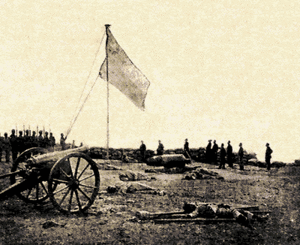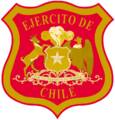Pedro Lagos facts for kids
Quick facts for kids
Pedro Lagos Marchant
|
|
|---|---|

Brigadier General Pedro Lagos
|
|
| Born | 1832 Chillán, Chile |
| Died | 18 January 1884 (aged c52) Concepción, Chile |
| Allegiance | |
| Service/ |
|
| Rank | Brigadier General |
| Battles/wars | Revolution of 1859 Occupation of Araucanía War of the Pacific
|
Pedro Lagos Marchant (born in 1832 – died January 18, 1884) was a brave Chilean army leader. He is best known for leading the attack and capture of the city of Arica during the War of the Pacific. This was a very important moment in Chilean history.
Contents
Growing Up in Chile
Pedro Lagos was born in Chillán, Chile, in 1832. His parents were Manuel Lagos y de la Jara and Rosario Marchant. After a big earthquake destroyed Chillán in 1835, his family moved to the countryside.
Pedro was the first of 15 children, and his family was quite poor. He started school in the rebuilt city of Chillán. Later, he went to a school started by a Spanish teacher named José Martínez.
In 1846, when he was 14, Pedro joined the Military School. He quickly showed he was a good student and became a 1st Corporal in February 1847. He later married his cousin, Juana Marchant Lagos, and they had one daughter named Isabel.
Starting His Military Journey
In March 1849, Pedro Lagos officially joined the Chilean Army as a 2nd Sergeant. He was part of the Chacabuco battalion.
In 1851, his battalion rebelled against the government. But Pedro was in Valparaíso at the time and chose to support the government. Because of this, he was promoted to Lieutenant.
He continued to rise through the ranks. By March 1852, he was an Adjutant Major, and by 1854, he was a Captain. He served in the cities of Chillán and Concepción.
During the Revolution of 1859, Pedro Lagos again supported the government. He helped in the siege of Talca and fought in the Battle of Los Loros. These actions earned him another promotion, this time to Sergeant Major.
Protecting the Araucanía Region
Around 1860, Pedro Lagos played an active role in the campaigns to secure the Araucanía region. His actions against the Pehuenche communities near the Biobío River led to his promotion to lieutenant colonel in 1866.
In 1867, he became the commander of the forces in Malleco Province and was put in charge of Angol. Like many officers at that time, he was given land for his service, specifically in the Mulchén area. In 1869, he left the army for a short time to work on his farm near Chillán.
The War of the Pacific
Pedro Lagos's most famous military actions happened during the War of the Pacific. In 1875, he was appointed as a local governor for Ñuble. In 1878, he was made commander in Mulchén.
In 1879, he joined the fight in the War of the Pacific. He took part in battles in Antofagasta, Tocopilla, Pisagua, and Jaspampa. In January 1880, he became the chief of the general staff. However, he later resigned due to disagreements with the army's top commander, General Erasmo Escala. He went back to the South of Chile.
In mid-1880, he returned to the army as an aide to General Manuel Baquedano. He fought in the campaign of Tacna and the Battle of Campo de la Alianza on May 26, 1880. This battle was very important because it ended the alliance between Peru and Bolivia. Pedro Lagos led a division that helped turn the tide of the battle, leading to a Chilean victory.
The Capture of Arica
The battle that made Pedro Lagos a Chilean hero was the attack and capture of the Morro de Arica (Arica Cape). This happened on June 7, 1880. General Baquedano gave him the order to capture the city and let him plan the attack himself.
Lagos decided to attack head-on with 4,000 infantry soldiers, divided into three groups. Their targets were the three main defenses of the city: the East fort, the Ciudadela (Citadel) fort, and finally the Cape fort.
The Peruvian defenders at the first two forts were surprised and quickly defeated. They then retreated to their main defense, fighting bravely. Lagos initially planned to wait for more soldiers before attacking the Cape. However, an unknown soldier shouted, "¡Al morro muchachos!" ("To the Cape, boys!"), which led to a massive charge.
The entire attack, from start to the capture of the Cape, took only 55 minutes. It was a heroic achievement. However, after the battle, there was a lack of control over the attacking troops. This led to the killing of some surviving Peruvian soldiers and citizens, and the city was looted.
After the Battle
Pedro Lagos continued his military service. He played an important part in the Lima Campaign, fighting in the battles of San Juan and Miraflores.
In March 1881, he became the Commander in Chief of the Chilean forces occupying Peru, replacing General Baquedano. His time in charge was controversial because of his very strict rules for the citizens of Lima.
On June 18, 1881, the Chilean Senate promoted him to Brigadier General. He was sent back to Chile and given a new role. Finally, he was named Commander-at-Arms of the Santiago garrison on November 23, 1881. Pedro Lagos died on January 18, 1884, in the city of Concepción.
Images for kids
See also
 In Spanish: Pedro Lagos para niños
In Spanish: Pedro Lagos para niños





